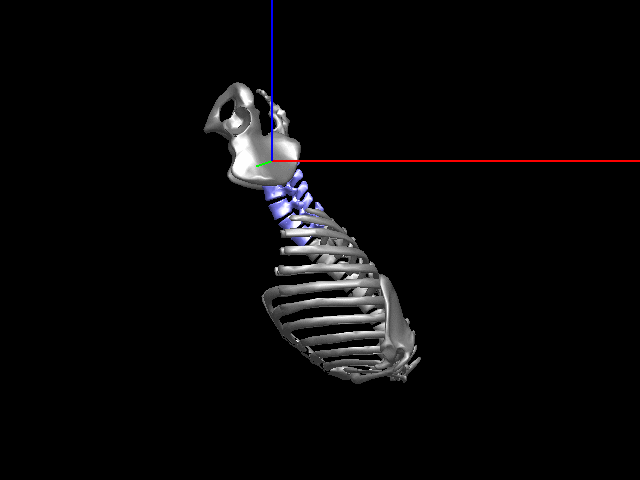
At the University of Stuttgart I've been working to improve the accuracy of the muscle models that are used in simulations of whiplash injury. This work has also included experiments at the FKFS! You can see some videos describing the experiments here:
- Experiment prepration: Instagram reel
- Driving simulator experiment Instagram reel

This simulation shows the response of the VIVA+ head-neck model to a 4.2g acceleration. The video has been slown down from its original 400 ms duration. The pink model shows the response when the muscles are Hill-type muscle models. The blue model shows the response when the muscles are VEXAT muscle models, which include titin, and are stiffer when actively lengthened which reduces the movement of the head. This video was presented at IRCOBI 2023 in Cambridge, UK. (paper)(pdf)
Assistive DevicesIn my last year working at Heidelberg University with Katja Mombaur as a part of HeiAge we were faced with the problem of developing a robotic walker to assist older adults getting into and out of a chair. This is a very difficult problem because it is completely unknown what kind of assistance people actually want. Without this information it's nearly impossible to make a compact and lightweight robotic walker.
And so, I came up with the idea of making a special-purpose laboratory robot to study human-robot-interaction during sit to stand. I did the mechanical design work on the frame while Peter Wittlinger and Wolfgang Stumpfs worked on the electrical system that would run two large Festo Linear gantry robots. Siddharth Maraje was able to get Festo's controllers to communicate with a control computer using a speedgoat interface. With that, we had turned two Festo pick-and-place robots and a pair of Robotiq force-sensing handles into a very large sit-to-stand haptic robot. Since then the project has been taken over by Dr. Marko Ackermann who is evaluating the sit-to-stand assistance profiles that younger and older adults prefer as a part of project HeiAge.
All of this work is being done in an effort to design an advanced robotic walker. Until it is known what kind of assistance older adults prefer, it just isn't possible to do a good job designing such a walker. Hopefully this work will make better devices possible in the future.
While taking part as a participant in Giorgos Marinou's experiment to evaluate an exoskeleton in a HeiAge study, I failed on one trial to get out of the chair. This exoskeleton is open-loop and its joints are not back-driveable, so once it starts to fall there is nothing that I can do. I'm really glad that we had the safety harness!
A video of the optimal lifts (paper)(pdf)
- Left: least-squares fit to experimental data
- Middle: optimal control solution for un-aided box lifting
- Right: optimal control solution for exoskeleton-aided box lifting
A video of the simulated interaction forces between the exoskeleton and the human (paper)(pdf)
Predicting the influence of hip and lumbar flexibility on lifting motions using optimal control (2018) (paper)(pdf)
Locomotion
A quick turn of foot: rigid foot-ground contact models for human motion prediction (2019) (paper) See the supplementary material (url) the foot model code. (pdf)
The video shows
- Grey (left): least-squares kinematic fit to experimental data
- Red (middle): optimal gait that minimizes the integral of muscle activation squared
- Blue (right): "optimal gait ... " but with a different foot
Notice the big spike in ground force in the red model? See the paper for details, but this spike is the result of the foot-ground contact model and the cost function interacting to produce an in-human result.
The key take aways:
- The foot influences the solution dramtically
- A foot that performs well during a least-squares problem might cause problems during the OCP
RBDL stands for Rigid-Body-Dynamics-Library (code) which is a C++ implementation written started by Martin Felis of Featherstone's dynamics methods (book).

Lumbar spine pendulum using the coupled constraints of Christophy et al. (paper). Geometry from BodyParts3D (paper)

Minimal torque squared solution of a swing-up pendulum implemented using constraints




